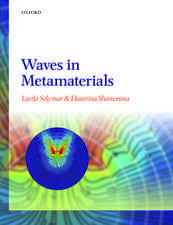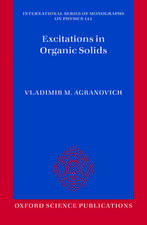The Janus Fluid: A Theoretical Perspective: SpringerBriefs in Physics
Autor Riccardo Fantonien Limba Engleză Paperback – 3 iun 2013
Din seria SpringerBriefs in Physics
-
 Preț: 477.94 lei
Preț: 477.94 lei -
 Preț: 200.36 lei
Preț: 200.36 lei -
 Preț: 346.92 lei
Preț: 346.92 lei -
 Preț: 312.68 lei
Preț: 312.68 lei -
 Preț: 317.76 lei
Preț: 317.76 lei -
 Preț: 381.00 lei
Preț: 381.00 lei -
 Preț: 311.69 lei
Preț: 311.69 lei -
 Preț: 387.25 lei
Preț: 387.25 lei -
 Preț: 380.07 lei
Preț: 380.07 lei - 17%
 Preț: 359.22 lei
Preț: 359.22 lei -
 Preț: 477.72 lei
Preț: 477.72 lei -
 Preț: 379.86 lei
Preț: 379.86 lei -
 Preț: 378.92 lei
Preț: 378.92 lei -
 Preț: 378.92 lei
Preț: 378.92 lei - 15%
 Preț: 461.73 lei
Preț: 461.73 lei -
 Preț: 413.07 lei
Preț: 413.07 lei -
 Preț: 377.18 lei
Preț: 377.18 lei - 15%
 Preț: 463.85 lei
Preț: 463.85 lei -
 Preț: 376.59 lei
Preț: 376.59 lei -
 Preț: 344.53 lei
Preț: 344.53 lei - 15%
 Preț: 462.70 lei
Preț: 462.70 lei -
 Preț: 475.06 lei
Preț: 475.06 lei -
 Preț: 377.73 lei
Preț: 377.73 lei -
 Preț: 345.89 lei
Preț: 345.89 lei -
 Preț: 378.12 lei
Preț: 378.12 lei - 15%
 Preț: 464.18 lei
Preț: 464.18 lei -
 Preț: 376.80 lei
Preț: 376.80 lei -
 Preț: 409.43 lei
Preț: 409.43 lei -
 Preț: 407.67 lei
Preț: 407.67 lei -
 Preț: 377.57 lei
Preț: 377.57 lei -
 Preț: 380.84 lei
Preț: 380.84 lei - 20%
 Preț: 387.06 lei
Preț: 387.06 lei -
 Preț: 377.73 lei
Preț: 377.73 lei -
 Preț: 380.07 lei
Preț: 380.07 lei - 15%
 Preț: 460.57 lei
Preț: 460.57 lei -
 Preț: 346.23 lei
Preț: 346.23 lei -
 Preț: 343.72 lei
Preț: 343.72 lei -
 Preț: 349.80 lei
Preț: 349.80 lei - 15%
 Preț: 463.53 lei
Preț: 463.53 lei -
 Preț: 376.04 lei
Preț: 376.04 lei -
 Preț: 376.80 lei
Preț: 376.80 lei -
 Preț: 475.65 lei
Preț: 475.65 lei -
 Preț: 376.22 lei
Preț: 376.22 lei -
 Preț: 376.80 lei
Preț: 376.80 lei - 15%
 Preț: 462.38 lei
Preț: 462.38 lei -
 Preț: 346.27 lei
Preț: 346.27 lei -
 Preț: 450.33 lei
Preț: 450.33 lei -
 Preț: 376.22 lei
Preț: 376.22 lei
Preț: 375.07 lei
Nou
Puncte Express: 563
Preț estimativ în valută:
71.77€ • 74.94$ • 59.26£
71.77€ • 74.94$ • 59.26£
Carte tipărită la comandă
Livrare economică 15-29 aprilie
Preluare comenzi: 021 569.72.76
Specificații
ISBN-13: 9783319004068
ISBN-10: 3319004069
Pagini: 60
Ilustrații: X, 50 p. 14 illus., 4 illus. in color.
Dimensiuni: 155 x 235 x 3 mm
Greutate: 0.11 kg
Ediția:2013
Editura: Springer International Publishing
Colecția Springer
Seria SpringerBriefs in Physics
Locul publicării:Cham, Switzerland
ISBN-10: 3319004069
Pagini: 60
Ilustrații: X, 50 p. 14 illus., 4 illus. in color.
Dimensiuni: 155 x 235 x 3 mm
Greutate: 0.11 kg
Ediția:2013
Editura: Springer International Publishing
Colecția Springer
Seria SpringerBriefs in Physics
Locul publicării:Cham, Switzerland
Public țintă
ResearchCuprins
What is a Janus Fluid?.- Introduction.- The Classical Statistical Physics Problem.- Experimental Methods.- Numerical Simulations.- Relationship between the Structure and the Thermodynamics.- The Phase Diagram of a Janus Fluid.- The Structure of a Janus Fluid.- Clustering and Micellization in a Janus Fluid.- Introduction.- The Kern and Frenkel Model.- Clustering Properties.- A Cluster Theory for Janus Particles.- Relationship between the Configurational Partition Functions.- Results.
Recenzii
From the reviews:
“The new brief book reviews the present advances in the theory of Janus fluids. … The book is written at a graduate student level of comprehension and should be of some use for the student who wishes to undergo research work in the field of soft matter and biophysics, or for the soft matter and biophysics scientist as a point of reference on the Janus fluid.” (Claudia-Veronika Meister, zbMATH, Vol. 1287, 2014)
“The new brief book reviews the present advances in the theory of Janus fluids. … The book is written at a graduate student level of comprehension and should be of some use for the student who wishes to undergo research work in the field of soft matter and biophysics, or for the soft matter and biophysics scientist as a point of reference on the Janus fluid.” (Claudia-Veronika Meister, zbMATH, Vol. 1287, 2014)
Notă biografică
Riccardo Fantoni was born in Livorno on the 30 August 1970, lived in Pisa until 1995 where graduated “cum laude” in the department of Physics of the University. Then moved to the University of Illinois at Urbana/Champaign until 2000 and in 1997 got a Master in Physics. Moved to Trieste and in 2004 got a Ph.D. in Physics. From 2005 to 2008 worked at the Chemical Physics department of the University of Venice as a postdoctoral fellow. From 2009 to 2012 worked at the National Institute for Theoretical Physics of the University of Stellenbosch as a postdoctoral fellow.
Textul de pe ultima copertă
The state-of-the-art in the theoretical statistical physics treatment of the Janus fluid is reported with a bridge between new research results published in journal articles and a contextual literature review. Recent Monte Carlo simulations on the Kern and Frenkel model of the Janus fluid have revealed that in the vapor phase, below the critical point, there is the formation of preferred inert clusters made up of a well-defined number of particles: the micelles and the vesicles. This is responsible for a re-entrant gas branch of the gas-liquid binodal. Detailed account of this findings are given in the first chapter where the Janus fluid is introduced as a product of new sophisticated synthesis laboratory techniques. In the second chapter a cluster theory is developed to approximate the exact clustering properties stemming from the simulations. It is shown that the theory is able to reproduce semi-quantitatively the micellization phenomenon.
Caracteristici
Represents a s state-of-the-art report of the Janus fluid Contains recent Monte Carlo simulations of Kern and Frenkel model of the Janus fluid Presents new sophisticated synthesis techniques for Janus fluid













